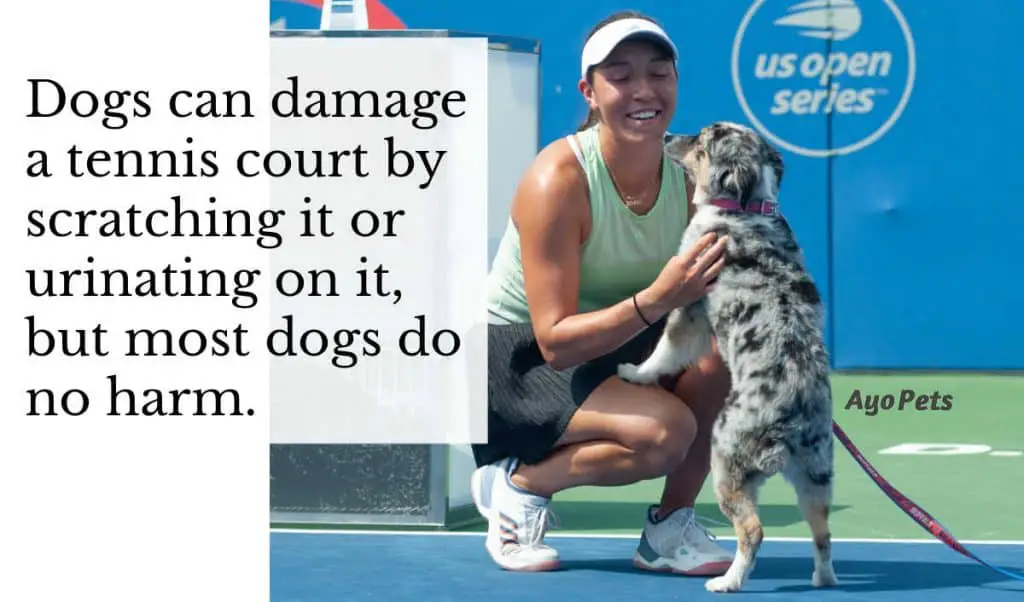I wanted to take my dogs for a play in the local park’s tennis courts the other day, but the sign on the fence clearly stated they weren’t allowed in. It turns out there’s a heated debate between dog lovers and players about letting dogs on tennis courts, with the main concern being the damage dogs cause to the courts.
After a lot of research, I found out that…
Dogs can damage tennis courts in a few ways: Dogs can dig holes in grass courts, and their claws might scratch clay or hard courts. Young, untrained, or unattended dogs could chew on and damage tennis gear, such as nets and balls. And any dog might urinate or defecate on the court or its surroundings.
Whether you think dogs should be allowed on tennis courts or not, it’s good to know all the ways dogs damage tennis courts, how often this damage actually happens, how tennis courts can harm dogs (I didn’t know this!), and how dog and court owners can prevent damage to the courts.
By the end of this post, you’ll know:
- The 6 ways dogs damage tennis courts
- If it’s common for dogs to damage tennis courts
- How to stop dogs from damaging tennis courts
6 ways dogs damage tennis courts
Dogs can damage tennis courts in the following ways:
Dogs dig holes in grass tennis courts
Dogs that are given access to a grass or synthetic tennis court and find a reason to dig might start digging a hole, which will damage the court’s surface. For example, a dog that’s left on its own on a court might start trying to dig its way out. Though dogs can cause a lot more damage to real grass than they ever can to artificial grass.
All dogs have the ability to dig, whether it is to dig things up, bury something, or get to a mole or pest they know is hiding underground.
Some dogs naturally have a stronger digging instinct, particularly terriers, dachshunds, beagles, and northern breeds, such as huskies. Other dogs only dig if they really have to. These are usually dogs that hunt using sight and smell, such as greyhounds and whippets.
But each dog is different, and it depends a lot on their individual personality and the circumstances whether they dig or not. This means that digging can be unpredictable and you never know which dog will dig a hole in a tennis court and when.
Dogs scratch tennis courts
If a dog with long nails is allowed on a hard or clay tennis court, the dog’s nails could scratch the court’s surface. Scratches make the court look shabby and, over time, add to general wear and tear and maintenance costs.
Dogs dirty tennis courts
Dogs can track mud and dirt onto a tennis court, no matter what type of court it is. If dogs are allowed on a tennis court, the court will most likely have to be cleaned more often than a court where dogs aren’t allowed.
Dogs can rip the tennis net
Some dogs can’t stay away from a tennis net. They might bite the net, catch it with their paws, run into it because they don’t see it, or do a combination of these things.
While tennis nets are made to withstand 1 200 hours of harsh sunlight a year and being hit by fast balls, the nets aren’t strong enough to survive a dog’s teeth or claws, which can make holes in a net quite easily.
Dogs chase and chew tennis balls
Tennis balls on a tennis court may also be damaged by dogs, especially any of these 21 dog breeds that love playing fetch.
Dogs that were bred to hunt, retrieve, and herd often can’t help themselves when a ball is near, and they’ll gladly chase and chew on tennis balls. This makes it unrealistic to think that a dog will sit still while you enjoy hitting a ball from one side of a court to the other.

Dogs might relieve themselves on a tennis court
- When dogs have to go, they have to go…
Dogs usually do their business outside, on grass if they have access to it. So if a dog is on a tennis court, especially a grass or synthetic court, there’s a good chance the dog will urinate or even defecate (poop) on the court if nature calls.
- But sometimes it’s a territorial thing…
If a dog is allowed on a tennis court and urinates there, then pretty much any dog that comes after that dog will urinate in the same spot to mark the area as their territory.
Whatever the reason for a dog urinating or defecating on a court, it is unhygienic, makes the court smell bad, and can damage the surface of the court over time.
Do dogs usually damage tennis courts?
Though it’s possible for dogs to damage a tennis court, it isn’t common and most dogs don’t do any damage at all. For example, scratches on a tennis court are much more likely to be from tennis racquets hitting the surface than from a dog’s nails.

Dogs are not a leading cause of damage to tennis courts because:
- Most tennis courts are off-limits to dogs, so dogs don’t have a chance to damage the courts.
- Many dogs don’t want to step on the hot surface of a tennis court, especially a hard court where the asphalt surface is usually about 15 – 20 ℉ hotter than the air around it. This temperature difference can burn a dog’s paws, even on a cloudy day!
- Dogs can only scratch a tennis court if their nails are long enough and they run around on the court or start digging. A dog with short nails probably won’t scratch the court at all, even if they run around.
- Well-trained dogs and dogs on leashes can’t get close enough to chew on a tennis net or chase tennis balls.
In fact, some tennis courts can cause far more damage to dogs than what dogs can cause to the courts. For example, hard courts have high temperatures that burn paws, and their rough and hard surface means they often break a dog’s nails or damage a dog’s paws.
How to stop dogs from damaging a tennis court
There are a few things you can do to stop dogs from damaging a tennis court. Below are the best tips and products from Amazon that I could find:
- Close off the tennis court with a fence or strong boundary net, to stop dogs from going into the area altogether. Put up a No Dogs Allowed sign, to make it clear that no dogs are allowed on the court. You can also use a padlock to lock the gate to the courts, so there will be no unauthorized entry.
- Provide an alternative: offer a nearby fenced-off, dog-friendly area where dogs can run around and play while their owners play tennis.
- If dogs are allowed on a tennis court, dog owners should make sure that their dogs’ nails are kept short. Dogs can wear paw protectors while on a court, to protect the court from scratches and the dog’s paws from getting burned or hurt.
- Dog owners should be asked to watch their dog on a tennis court and the expectations should be made clear to them: If a dog relieves itself on the court, tracks mud or dirt onto the court, or chews and moves things around like tennis balls, the owner is responsible for cleaning up or replacing items. Fines can be imposed for not following these rules.
- Put up two or three outdoor, wireless cameras to keep an eye on who uses the court with their dogs and what their dogs are doing. Doing this and putting up a sign that tells people they’re being watched is often enough to limit negative behaviors.






